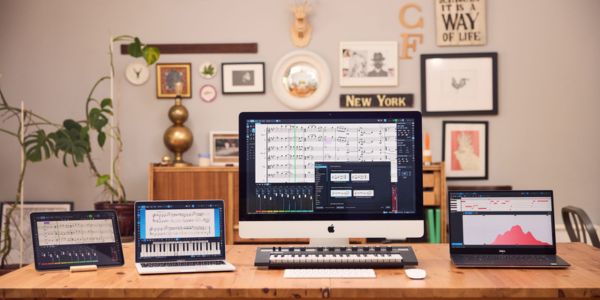
In 1995 I was introduced to Finale, 2007 to Sibelius, and in 2020 to Dorico. Having used Finale and Sibelius extensively over the past 30 years, I was interested in digging into Dorico during Melbourne’s lockdowns to see what all the fuss was about. I haven’t stopped using it since. While I still use Finale and Sibelius when required by a particular publisher or project, Dorico has become my go-to notation program for my own arrangements and orchestrations.
The most immediate thing that sets Dorico apart from the competition is that it appears to “think” about your score as music, rather than a collection of fonts arranged on some horizontal lines. If you have entered chord symbols on a vocal part, it knows that bar 20 has a G7 chord across the whole score, not just for the vocalist. So if your soloist needs some chord symbols, it’s easy to apply them to their part for that region (transposed appropriately) without needing to re-enter them. Should the chords be edited down the track, you only need to edit them on one of the staves, and it’s reflected on every stave that has chords.
Dorico knows you have players, not instruments. If your player is holding an alto sax, tenor sax and flute, it’s no problem at all. Dorico will look after all the instrument changes and layout challenges. If you later decide to have a dedicated flautist, you can simply drag that instrument to a new player, and it will reformat accordingly.
Information is largely entered using “popovers”. Need to enter dynamics? Select a region of one or more staves (Shift+D) then simply type in p<mf to get a p at the start of your selection, a crescendo across the selection, then an mf at the end of the selection, on every stave selected. Decide that you really wanted f at the end? Double click one of the mfs, change it to f, and the change will be replicated across all the staves you originally selected. Popovers cover almost all aspects of notation entry and greatly speed up productivity.
Dorico’s condensing feature is a godsend for orchestral scores. In “gallery view” – scroll or panorama view to Finale and Sibelius users – two flutes, two oboes and two clarinets each get their own part (six parts) and take up six systems, but will naturally condense to three systems in the score. Similar rhythms share stems, different rhythms will have opposing stems. All done seamlessly and formatted perfectly.
There are two main editing modes – “Write” and “Engrave” – so you can’t accidentally change the pitch of a note when you’re trying to adjust the look of the score. “Play” mode is like a miniature DAW, allowing you to not only mix, but do some rudimentary automation.
The only negative I have found to using Dorico is that on my mid-2015 MacBook Pro, large orchestral scores can cause the software to respond a little sluggishly as they near completion.
Overall, I love this program. I have also found the online support to be extremely responsive and helpful, and the program is constantly improving. If you’ve wondered what all the fuss is about, it’s about a lot of good stuff. Dorico 4 has just released, so check it out today.
Dorico is available for Mac OS, Windows and iPad.
Jared Haschek
